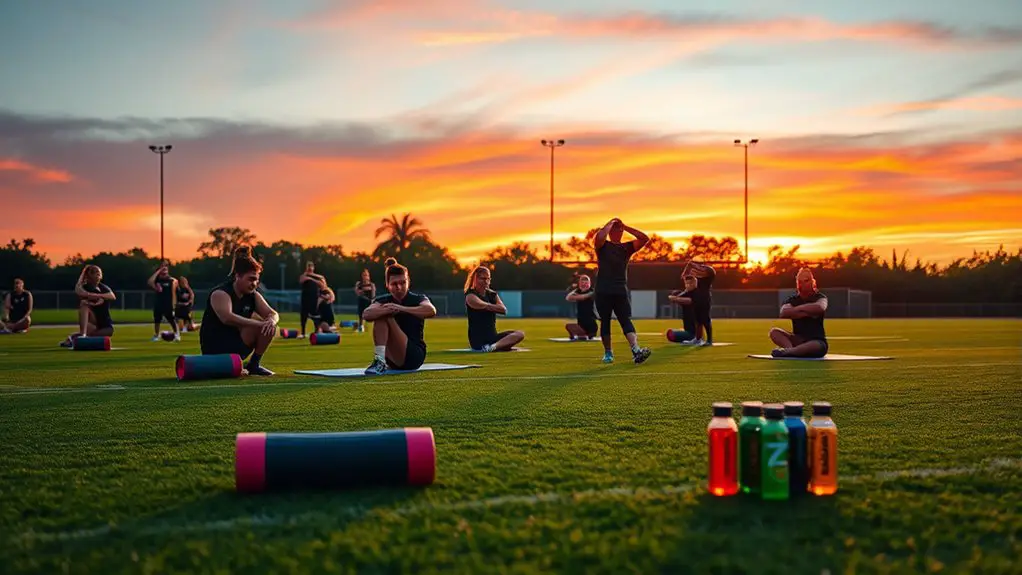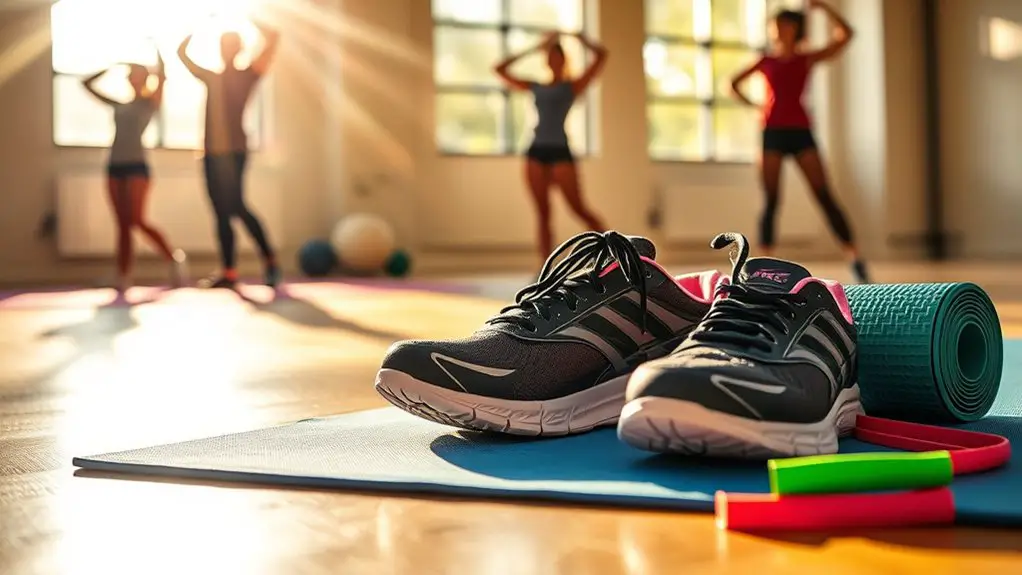Active recovery is essential in your athletic training because it helps you maintain engagement while promoting muscle recovery. With low-intensity activities, you boost blood circulation, reduce soreness, and lower injury risks. It's more effective than complete rest, keeping your flexibility intact. By incorporating various activities, you not only prevent boredom but also find a balance that prepares you for future challenges. Discover how active recovery can enhance your routine further, making your training more effective and enjoyable.
Understanding Active Recovery
Active recovery is often misunderstood, but it plays an essential role in athletic training. You might think that taking a break means doing nothing, but that's not the case here. Active recovery involves low-intensity activities that help your body recover while keeping you engaged. Instead of collapsing on the couch, consider a light jog, yoga, or gentle cycling. These activities increase blood flow, helping to flush out toxins and reduce muscle soreness.
Understanding active recovery means recognizing that rest doesn't always mean inactivity. It allows you to maintain your fitness level while promoting recovery. Plus, it can be invigorating, giving you a sense of freedom as you move without the pressure of high-stakes performance. Embracing this approach can help you listen to your body and find balance, so you're ready to face your next challenge. Remember, staying active in recovery is your path to greater overall well-being. Additionally, active recovery enhances blood flow and recovery, which is crucial for effective healing and rejuvenation.
Benefits of Active Recovery for Athletes
Active recovery offers you several key benefits that can boost your athletic performance. By enhancing muscle recovery and improving blood circulation, you'll feel more energized and ready for your next workout. Plus, it can greatly reduce your risk of injury, keeping you in the game longer. Additionally, incorporating proper nutrition strategies can further enhance your recovery and performance.
Enhanced Muscle Recovery
While traditional rest days have their place, incorporating active recovery into your routine can greatly enhance muscle recovery for athletes. Instead of being completely sedentary, engaging in low-intensity activities like walking, yoga, or swimming allows your muscles to recover while still moving. This light movement helps reduce soreness, prevents stiffness, and can even boost your overall mood. You'll find that those gentle activities keep your body limber, helping you bounce back faster for your next workout. Plus, active recovery can help break the monotony of rest days, giving you a sense of freedom instead of feeling trapped. Ultimately, by embracing active recovery, you're not just resting; you're nurturing your body and preparing it for future challenges ahead.
Improved Blood Circulation
When you engage in low-intensity activities during recovery, you greatly enhance blood circulation, which is essential for muscle repair and overall performance. Improved circulation means your muscles receive more oxygen and nutrients, speeding up the recovery process. It helps flush out metabolic waste products like lactic acid, reducing soreness and fatigue. Plus, this boost in blood flow can invigorate your entire body, leaving you feeling more energized and ready to tackle your next challenge. You'll notice that with better circulation, your overall endurance and strength improve, allowing you to push your limits further. So, whether it's a gentle jog, yoga, or a leisurely swim, embrace active recovery to keep your body feeling free and capable.
Reduced Injury Risk
Engaging in low-intensity activities during recovery doesn't just promote muscle repair; it also greatly reduces your risk of injury. When you choose active recovery, you're keeping your muscles engaged without overexerting them. This helps maintain flexibility and range of motion, essential for avoiding strains or sprains. Plus, it allows your body to flush out toxins while delivering oxygen and nutrients to your muscles, aiding recovery.
Active Recovery vs. Passive Recovery
Active recovery and passive recovery serve distinct purposes in athletic training, each playing an essential role in the recovery process. Active recovery involves engaging in low-intensity activities that promote blood flow and facilitate muscle repair. In contrast, passive recovery leans toward complete rest and relaxation. Depending on your training goals and needs, both methods can be beneficial.
Here's a quick comparison:
| Active Recovery | Passive Recovery |
|---|---|
| Involves light exercise | Involves complete rest |
| Increases blood flow | Minimal blood flow |
| Reduces muscle soreness | No immediate soreness relief |
| Enhances flexibility | No effect on flexibility |
| Promotes mental recovery | Can lead to stiffness |
Choosing the right recovery method can help you feel more energized and ready for your next workout. Additionally, incorporating active recovery activities can enhance post-cardio recovery and support overall performance. Listen to your body and switch between these methods to maximize your training benefits!
Types of Active Recovery Activities
While many athletes might think of intense workouts as the only path to success, incorporating various types of active recovery activities can greatly enhance your overall performance. Engaging in low-intensity exercises like walking or jogging helps maintain blood flow, aiding muscle repair. Yoga and stretching sessions are fantastic for promoting flexibility and relaxation, allowing your body to rejuvenate. Swimming is another excellent option, providing a full-body workout without the strain of traditional exercises.
Cycling at a leisurely pace can also keep your legs moving while minimizing impact on your joints. Dance classes or light sports like badminton can be enjoyable ways to stay active while offering a mental break from rigorous routines. Ultimately, choosing activities you genuinely enjoy will make recovery feel less like a chore and more like a revitalizing escape. Additionally, staying hydrated during these recovery activities is crucial for optimal performance, so remember to sip water regularly. Embrace your freedom to explore these diverse options and watch your athletic journey flourish.
Incorporating Active Recovery Into Training Routines
Integrating active recovery into your training routine can make a significant difference in your performance and overall well-being. It's not just about hitting the gym hard; it's about giving your body the chance to recover while still staying engaged. Here's how you can seamlessly incorporate active recovery:
- Schedule Recovery Days: Set aside specific days for lighter activities like walking, swimming, or yoga to keep your body moving without overexerting it.
- Mix It Up: Try different activities each week to prevent boredom. Whether it's cycling, hiking, or dancing, find what excites you.
- Listen to Your Body: Pay attention to how you feel. If you're fatigued, prioritize gentle movement to aid recovery and recharge your energy. Additionally, rest days are essential for overall training success, allowing your muscles time to recover and grow.
The Role of Nutrition in Active Recovery
Nutrition plays an essential role in enhancing your active recovery process, as it provides the necessary nutrients your body needs to repair and rejuvenate itself. After you've pushed your limits, refueling with the right balance of carbohydrates, proteins, and healthy fats is vital. Carbs help replenish glycogen stores, while protein aids muscle repair and growth.
Don't forget hydration; it keeps your body functioning effectively. Incorporating fruits and veggies into your meals not only provides vitamins and minerals but also antioxidants that combat inflammation. Additionally, prioritizing adequate protein intake is crucial for reducing soreness and accelerating recovery time.
Listening to your body is key. If you crave something, it might be your body signaling a nutrient deficiency. Keep it simple and focus on whole foods to fuel your recovery. Embrace the freedom that comes with nourishing your body, as it sets the stage for your next challenge. Remember, great performance starts with solid nutrition, so prioritize it during your recovery days.
Monitoring Progress and Adjusting Recovery Strategies
As you begin your active recovery journey, monitoring your progress and adjusting your strategies is essential for optimizing results. Keeping track of how your body responds helps you make informed decisions, ensuring you're on the right path to recovery.
- Track your workouts: Jot down your exercises, durations, and intensity levels to see what's working and what isn't.
- Listen to your body: Pay attention to signs of fatigue or discomfort. Adjust your recovery techniques accordingly and don't hesitate to take a step back if needed.
- Experiment with different methods: Try various recovery strategies, like yoga, swimming, or foam rolling. Find what resonates with you and enhances your recovery experience. Incorporating foam rolling techniques into your routine can significantly boost muscle recovery and relieve tension.
Enhancing Mental Well-Being Through Active Recovery
Recovery isn't just about your physical state; it's also a chance to enhance your mental well-being. When you engage in active recovery, you're not just giving your body a break; you're also clearing your mind. Activities like yoga, light jogging, or cycling can lift your mood and reduce stress. You're free to explore different forms of movement that resonate with you, allowing you to connect with your body in a more relaxed way. Incorporating yoga poses for muscle recovery can further deepen this connection and support your mental clarity.
This mental shift can lead to improved focus and motivation, making you feel more energized and ready to tackle your next training session. By actively participating in your recovery, you cultivate mindfulness, which promotes emotional resilience. Plus, taking this time for yourself can provide a sense of freedom from the pressures of training, helping you recharge mentally. Embrace active recovery as an essential part of your routine, and you'll likely find your overall performance improves, both on and off the field.
Frequently Asked Questions
How Does Sleep Impact the Effectiveness of Active Recovery?
Sleep greatly affects your active recovery. When you're well-rested, your body repairs itself more efficiently, reducing soreness and enhancing performance. Skimping on sleep can hinder your progress, so prioritize those restful nights for ideal recovery.
Can Active Recovery Be Used During Injury Rehabilitation?
Absolutely, you can use active recovery during injury rehabilitation. It helps maintain blood flow, reduces stiffness, and can facilitate healing. Just listen to your body, and adjust activities based on your comfort and recovery progress.
What Are Common Misconceptions About Active Recovery?
You might think active recovery's ineffective or only for elite athletes. Some believe it's just light exercise, but it's more about promoting blood flow and aiding recovery. Embrace it; it can benefit everyone, including you!
How Often Should I Incorporate Active Recovery Sessions?
You should incorporate active recovery sessions at least once or twice a week, depending on your training intensity. Listening to your body's signals is key; it'll guide you in finding the right balance for recovery.
Can Active Recovery Improve Performance for Non-Athletes?
Isn't it fascinating how something as simple as active recovery can enhance your performance? For non-athletes, incorporating these sessions can boost energy, reduce stress, and improve overall well-being, giving you the freedom to thrive in daily life.




